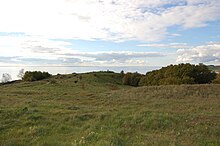Little Zicker
Klein Zicker is a peninsula belonging to the Baltic Sea island of Rügen . It is part of the Mönchgut peninsula , at the southern end of which it lies and with which it is connected in the southeast by a 130-meter-wide isthmus . Klein Zicker is around 750 meters long and up to 650 meters wide.
In the east and north, Klein Zicker borders the Zicker See , in the west and south-west there is the Greifswalder Bodden . On Klein Zicker is the village of Klein Zicker , which belongs to the Mönchgut municipality . The interior of the peninsula is hilly and rises to a height of 38 meters. A steep coast is pronounced on the west bank . There is a vantage point above the cliff that allows a wide view of Mönchgut and the Greifswalder Bodden. The northern tip of the peninsula is formed by the Lüttzicker Urt hook . In the east of the peninsula there is the Klein Zicker harbor, which is mainly used by fishing.
At the beginning of the 18th century, Swedish troops built the ski jump near Klein Zicker on a hill , the remains of which can still be seen in a small wooded area. At the beginning of the 19th century, the Swedes planned to build the port city of Gustavia on Klein Zicker, but the plans were ultimately not implemented. During the GDR era , parts of the peninsula were used by the Soviet military. After the abandonment of this use, ruinous buildings, barbed wire fences, wrecked cars and rubbish were left behind. Renaturation began in 1997. The military buildings were torn down and 45,000 m³ of rubble and rubbish removed, and the trenches and building terraces were leveled. Care was taken to give the surface the curves typical of the Pleistocene moraine core and to restore the original landscape. A total of 37,000 m³ of earth was moved. A dry grass mixture adapted to the original vegetation was applied to eight hectares to prevent soil erosion . This created a species-rich dry and poor grassland. The biotope is maintained through regular grazing.
literature
- Georg Jung: embracing the sea and chalk green. Rügen from A – Z. Ellert & Richter, Hamburg 2009, ISBN 978-3-8319-0381-8 , p. 74.
Coordinates: 54 ° 17 ' N , 13 ° 41' E



